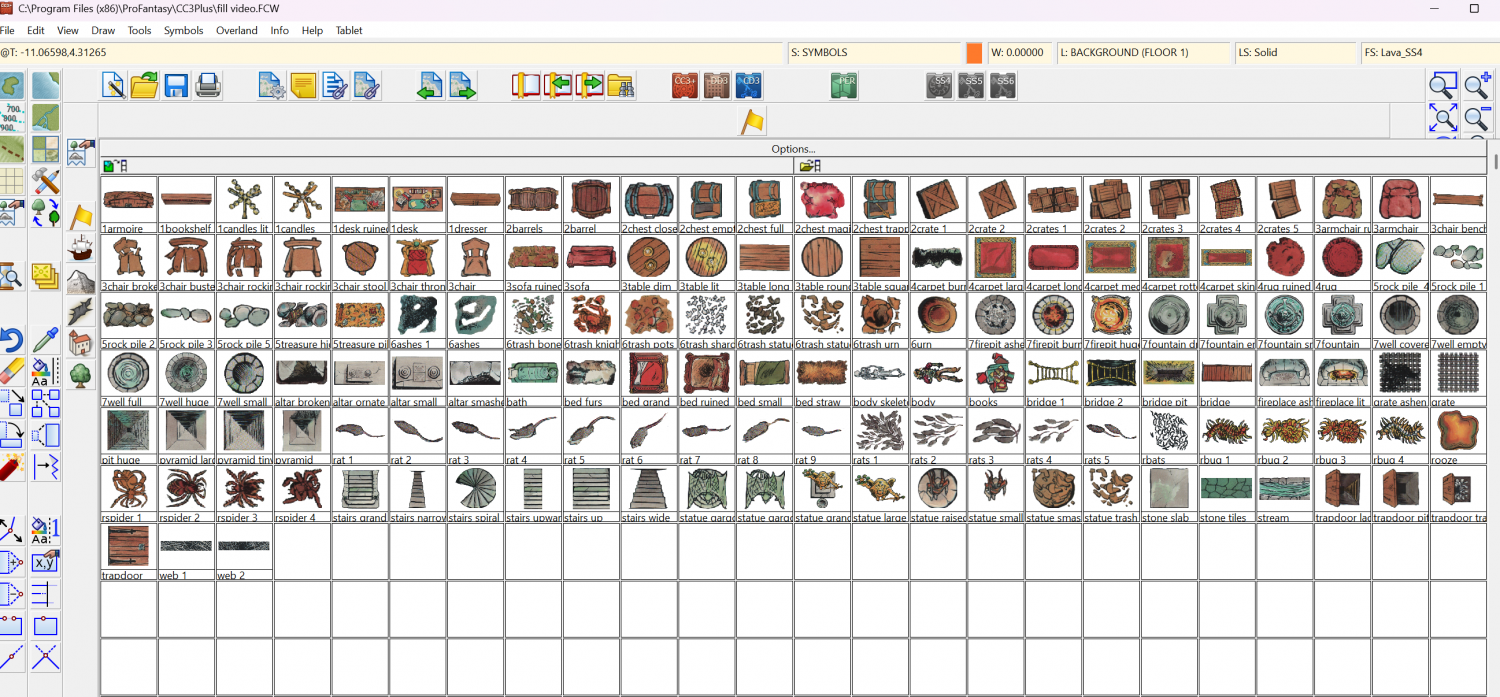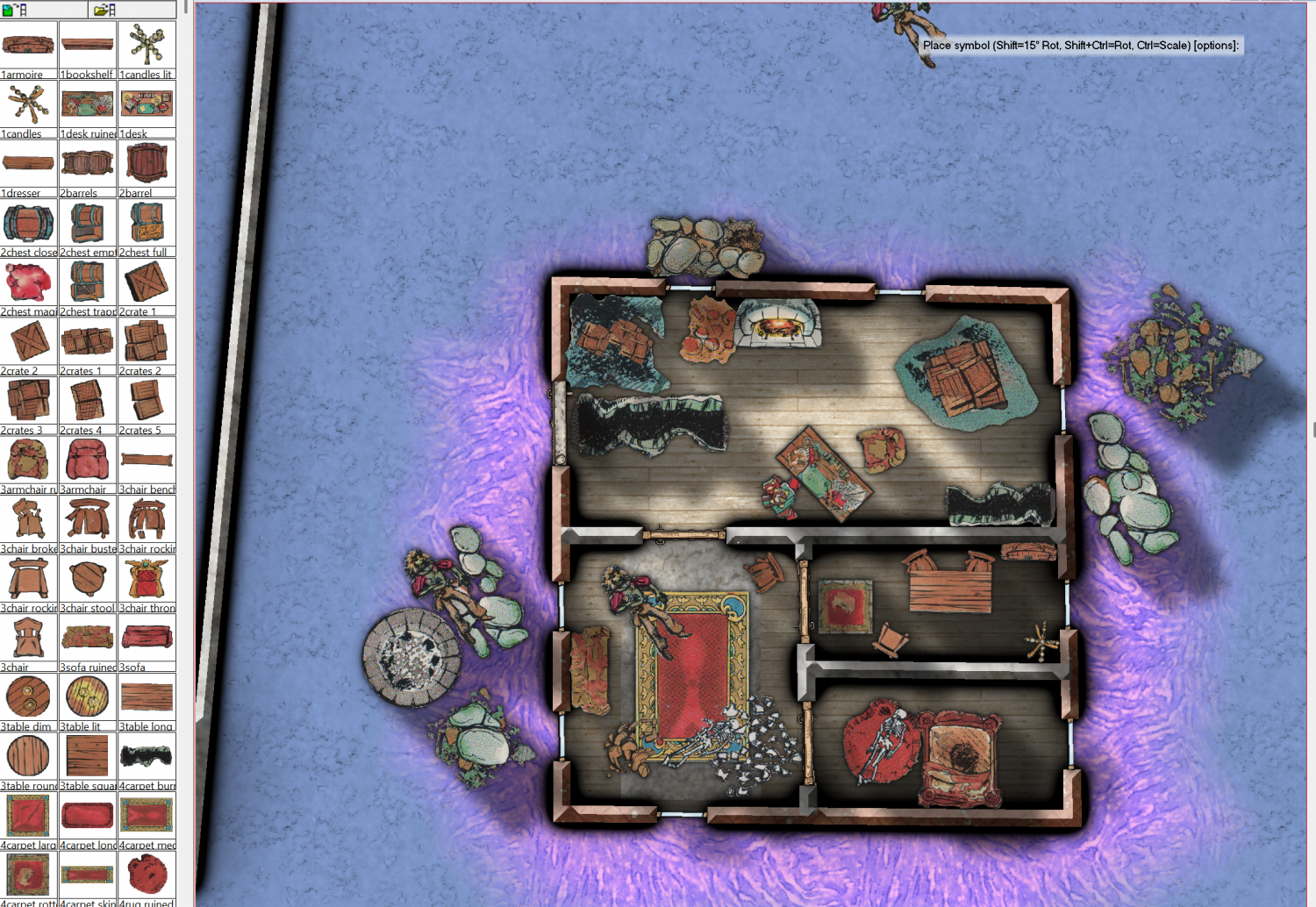Dungeon Tiles 1984
So I bought these dungeon tiles new in 1984. Only used them a few times. Boxed them up until 2002. Then I decided to scan them all. Took me forever due to computer and scanner speeds back then.
Manually edited all the white to transparent, another really time consuming project on its own, as it was a digtal eraser process, using smaller and smaller erasers each time. So those have just sat dormant on digital storage for another 20 years.
Just tonight I decided to try make them into symbols and wow that was a pretty easy process. 147 symbols in a few minutes, then into a symbol catalog.
This is just a super fast 2 minute map to try the symbols out. Then a picture of the symbols in a catalog.
Did anyone ever have these tabletop tiles, or similar products? Cool thing about them is they were double sided. Good drawing on one side, dilapidated on the opposing side.





Comments
For their age they are really lovely. Computer art was still in it's infancy back then (if I remember correctly), so all of these must have been drawn on paper and scanned in. So the artist didn't have access to CTRL+Z, or any fancy layer blending techniques. He or she just drew and painted them.
Do you remember the artist?
Heck no, I may be able to trace them down, looking through the product splash page. TSR (Wizards of the Coast) had some amazing artists back then.
Found it.
Dennis Kauth and Jim Roslof.
Yep both amazing unbelievably talented artists. Can't believe they did the tiles.
The art and cartography these guys did is pretty mindblowing.
These two?
Yep those are the guys.
I definitely knew of Jim Roslof.
Didn't know Dennis Kauth, but know his work.
Awesome :)
Some are still going at it. My daughter and I bought a book from Tracy Hickman at Gen Con 2022. He asked her about her favorite D&D character with all the details. He drew it very well in the front of the book in about 2 minutes or less. We have it in a display case. He is still good. This is crazy because he wasn't even an artist when he was at at TSR! They decided they had better artists, so they made him just write text.
I have quite a few of the earliest items in this line, going back to the later 1970s. The earliest were some sheets of square floor tiles and wooden planks printed on card that you had to physically cut up to use. They weren't tiles as such, you just had to cut them to whatever corridor size and shapes you wanted. That's where the concept of geomorphs probably originated, to make best use of things like this. There were a few other bits and pieces with that, including a cut-up stone stair sheet, both straight and spiral, and some wooden doors. They were printed with a single colour per sheet, and good-quality, black, hand-drawn lines to show the texture. One of the stone colours was cream, with neatly-drawn, square and rectangular sub-tiles per 5-ft square (scaled for 25mm/28mm minis back then), the other stone was grey with numerous small "crazy-paving" style pieces per floor square, and a few bits missing to show it as "worn and very old", the stairs were grey with wavy-edged steps, so as to have a bit of character, and the wood doors and planking done in a pleasing red-brown. Can't recall who made them now; might have been the original Games Workshop - they were certainly the UK sellers.
Then in the early(-ish?) 1980s, I bought up a full set of the Steve Jackson Games "Cardboard Heroes" range of A-frame standee card minis, which also had to be physically cut-up from their full-colour-printed sheets, and which had a huge array of mini options for characters, monsters and all manner of flat-lain items. You can still buy these now, but as downloadable PDFs to print at home. They're still excellent, as the artwork quality was uniformly splendid, and at the time nobody else was making things like this. Spoilt for choice in home-print options these days, of course!
About the same time, I found a booklet called "The Compleat Tavern", published by Gamelords in 1981. This provided a whole array of tables and rules for running events of all kinds in taverns and bars in fantasy RPGs. Main reason I got it was because it had a loose foldout tavern plan printed on thick paper (mono printing on cream paper), which again came with cut-up sheets of items like tables, chairs, benches, etc, printed brown on darker cream thin card.
Subsequent to that was a set of pull-out and cut-up printed item sheets in an issue of either "Dragon" or "Dungeon" (the TSR in-house magazines of the period), which were simply printed black on flat-lain small rectilinear tile-shapes, suitable for the items involved (jars, barrels, chests, etc.). Can't recall what date that was now, but from the basic print-style, I'd guess sometime in the 1980s.
And lots more since, naturally, though I didn't come across anything quite like these 1984 pieces. Being in the UK though, getting hold of anything published in the States was often very difficult, and commonly expensive.
These symbols have really aged very well indeed.
I went to gen-con in 2015. Amazing experience. I didn't get to meet Tracy Hickman, but did meet Margret Weis. I heard that Tracy is just super awesome.
My daughter isn't super into D&D right now...but here's to hoping.
Yea it's was a crazy time mid eighties. UK couldn't get american stuff easy, and we in Canada couldn't get either very easily.
Carboard was a pretty big thing, because there wasn't a huge supply of mini's. Eventually they started to have mini stores. Then it became so over saturated and they went out of business.
Must admit, I assumed the rush to cardboard minis was simply cheapness and easy portability, as we had no shortage of cast metal wargames mini manufacturers in the UK during the 1970s. Minifigs aka Miniature Figurines started their Tolkien range in 1973, for instance (before all the litigation about names began, so ents were still ents, hobbits hobbits, etc.!), and a host more manufacturers came about within a few years of that, not all of whom survived long. Some were already making historical ranges (as Minifigs were), so the switch was pretty easy for those. And of course, there've been lots more since!
Mini for RPGs came from minis from wargaming, which goes way back. There were a lot of companies in the 70s and 80s making both, because casting lead (back before that was a crime against humanity, and not entirely without reason) is something you can do in your garage on a profitable basis.
But for a company already producing printed goods, adding carboard minis was a no-brainer for a little extra profit.